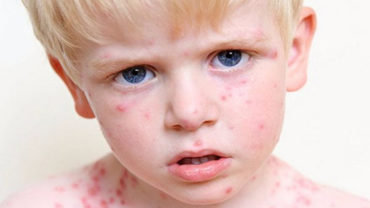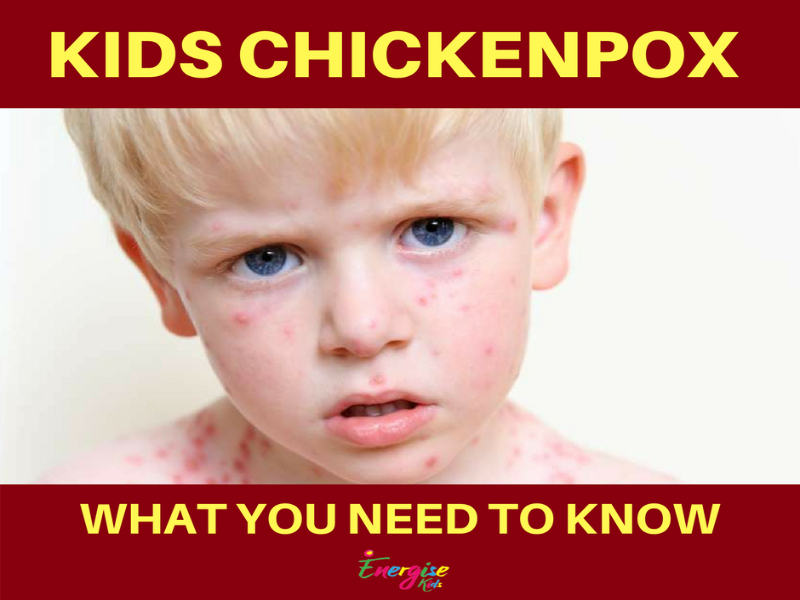Via Parents: 8 Facts About Chickenpox
Chickenpox, also called varicella, is a disease caused by the varicella zoster virus. Although many of us had it as children, we may not be up to date on all the facts. “Years ago, chickenpox was considered a benign, inevitable disease of childhood,” says Mary Anne Jackson, M.D., division director, infectious disease at Children’s Mercy Hospitals and Clinics in Kansas City, Missouri, and member of the American Academy of Pediatrics’ (AAP) committee on infectious disease. These days, chickenpox is less common thanks to a vaccine for the disease that was introduced in the U.S. in 1995. And while it’s true that the disease is usually mild in most children, it can be serious in some kids, teens, and adults.
Read on to learn what parents should know about chickenpox.
1. An itchy, red rash is the classic sign of chicken pox.
Chickenpox appears as an extremely itchy, blistery red rash that typically starts on the face and trunk before spreading to the rest of the body. Blisters can crop up anywhere, including in the mouth, eyelids, and genital area. The chickenpox rash progresses from red bumps to fluid-filled blisters to scabs. Other symptoms of the disease include fever, headache, and fatigue. People tend to be sick for five to ten days.
2. It is highly contagious.
Chickenpox can spread easily through the air when a person with the virus coughs or sneezes. It can also be spread by touching the fluid from chickenpox blisters. A person with chickenpox is contagious from one to two days before he gets the telltale rash until all of his chickenpox blisters have formed scabs. If exposed to the varicella zoster virus, it takes between 10 to 21 days to develop chickenpox. If your child gets chickenpox, he’ll have to stay home from school until the rash has completely crusted over, which is usually around day six or seven of the rash. Also, keep him away from other kids who haven’t had chickenpox or who haven’t been vaccinated against it, advises the AAP.
3. Chickenpox is usually mild but can be very serious.
For most healthy children, chickenpox, with its itchy rash, fever, and fatigue, is more of a nuisance than a danger. In some cases, though, chickenpox can lead to serious complications such as dehydration, pneumonia, bleeding problems, encephalitis (brain swelling), bacterial skin infections, toxic shock syndrome, and bone and joint infections. Certain groups, including infants, teens, adults, pregnant women, and people with weakened immune systems due to illness or medications, are at higher risk of complications from chickenpox. But even healthy children and adults can become seriously ill. Before the chickenpox vaccine became available, the disease sent about 11,000 Americans to the hospital and was responsible for about 100 to 150 deaths each year, according to the Centers for Disease Control and Prevention (CDC).
4. Chickenpox isn’t nearly as common as it used to be.
Before the chickenpox vaccine was introduced in the U.S. in 1995, chickenpox was one of the most common childhood diseases. “There were more than 4 million cases a year, and 90 percent of children contracted it by the time they were 9 years old,” says Dr. Jackson. “By 2010, the number of cases of chickenpox had decreased by more than 80 percent in children and 90 percent in babies.” The key to keeping those numbers low: Parents should continue to have their children vaccinated.
5. The chickenpox vaccine is your best defense against the disease.
The surest way to protect your child against chickenpox: Have him vaccinated, agree the CDC, American Academy of Family Physicians (AAFP), and American Academy of Pediatrics (AAP). “We’ve had a decade and a half to see how the vaccine works and it is very effective,” says Dr. Jackson. “In virtually 100 percent of cases it will prevent serious illness in otherwise healthy individuals. The “total efficacy” rate is between 80 and 85 percent, which means that between 15 and 20 percent of vaccinated people may still get chickenpox, but they’ll have a milder case. They’ll typically have fewer than 50 blisters (compared to a full-blown case with roughly 500 blisters), mild or no fever, and few other symptoms, according to the U.S. Department of Health and Human Services.
6. For the best protection, children (and adults) need two doses of the vaccine.
The CDC and AAP recommend that children get two doses of the chickenpox vaccine — the first at 12 through 15 months of age and the second between 4 and 6 years of age. (The second dose may be given earlier as long as it’s at least three months after the first dose.) People age 13 and older who have never had chickenpox are also encouraged to get immunized. They too should get two doses, scheduled at least 28 days apart.
7. You can usually manage your child’s symptoms at home.
If your child gets chickenpox, don’t be surprised if his pediatrician doesn’t tell you to bring him right in. “Bringing a child into the office risks spreading it in the waiting room,” says Rodney E. Willoughby, M.D., a pediatric infectious disease specialist at Children’s Hospital of Wisconsin, professor of pediatrics at the Medical College of Wisconsin, and member of the AAP’s committee on infectious disease. “Generally, a phone call suffices and, if needed, arrangements can be made to bring the child in through a separate entrance and directly into an exam room.”
If your child has a fever, you can give him acetaminophen. Never give aspirin or aspirin-containing products to a child with a fever from chickenpox, cautions the CDC. The use of aspirin has been associated with a serious disease called Reye’s syndrome that affects the liver and brain. The AAP also advises against giving your child ibuprofen as it can increase the risk of severe strep skin infections. Oatmeal baths and calamine lotion can help lessen the itchiness. Keep your little one’s fingernails trimmed and discourage him from scratching to avoid getting any of his chickenpox blisters infected or causing scars.
An antiviral medication called acyclovir can reduce the symptoms of chickenpox but it is usually only given in certain circumstances (such as when a child has eczema or asthma) and typically not to otherwise healthy children experiencing chickenpox without complications.
The AAP recommends that you call the pediatrician if your child has a temperature greater than 102 degrees, a fever that lasts for more than four days, or any signs of bacterial infection (for example, if the rash becomes tender, warm to the touch, extremely red, or starts leaking pus). Another time to call the pediatrician: if your baby develops a fever and widespread rash. His doctor will likely want to keep a closer eye on him to make sure what he has is actually chickenpox, and that no complications arise, explains Dr. Willoughby.
8. Once someone has chickenpox, he probably won’t get it again — but he could get a related disease called shingles.
After a person has chickenpox, the varicella zoster virus that causes it remains in the body in an inactive state. The virus can reactivate years later, which causes a disease called shingles. According to the CDC, there are about 1 million cases of shingles each year in the U.S. Anyone who has had chickenpox can get shingles but the risk increases as people age. There is now a vaccine for shingles that’s recommended for adults age 60 and older.



